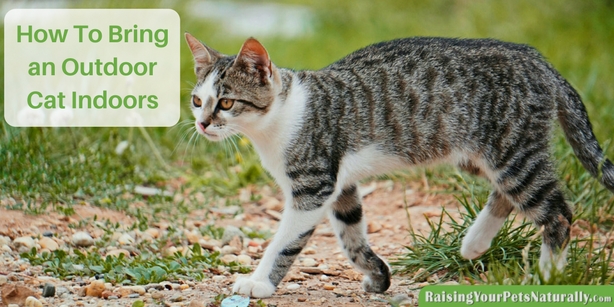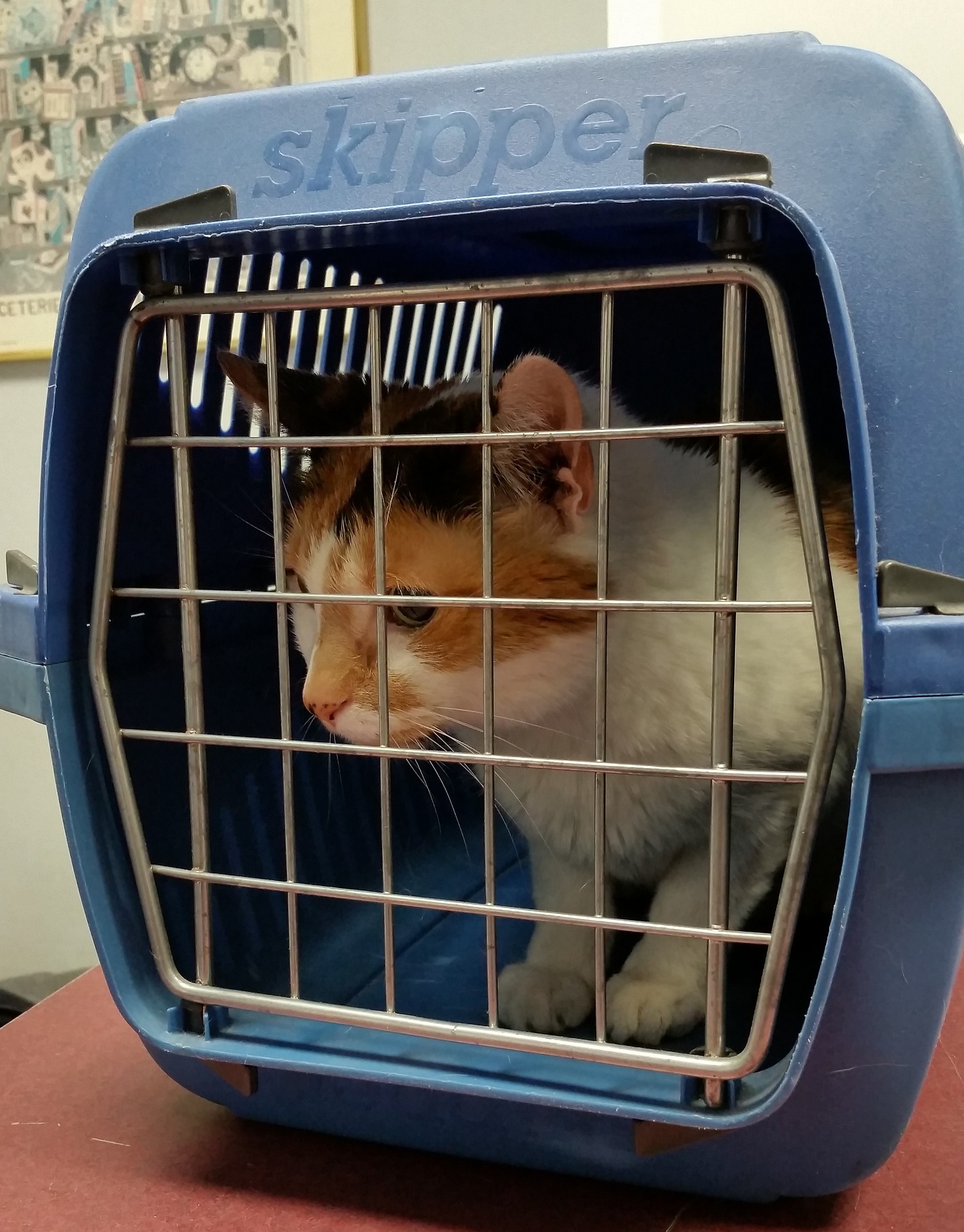Google Adsense—>

Cat Behavior and Cat Training
Bringing an Outdoor Cat Indoors

If you recall, Nutter The Cat was a stray cat that I brought into my home with the intentions of getting him into a local cat rescue. Well, that didn’t happen—he decided he was happy with me and didn’t have any intentions of leaving. But how did I transition this outdoor cat into an indoor cat?
First, I don’t think there is just one way to go about bringing an outdoor cat indoors. I’m sure a lot of people have tried various things with a variety of results. I can only tell you what I would suggest and why. I’d love to hear your success stories in the comments below!
Just Do It! There’s no time like the present. But really, you should prepare a bit before opening the front door to the outdoor cat.
- Cat Room– Decide on a good, warm and quiet room your cat can call his own, or at least where you can keep a lot of his belongings. Prepare it for your new cat. A warm bed, lots of fun cat toys, a variety of cat scratching posts, cat caves, hiding spots, healthy cat treats, fresh water, healthy cat food, and a litter box. Add some calming aids such as Feliway and calming music to his room.
- Litter Box- Choose a shallow and large litter box or a plastic sweater box. You want it to be very easy for your new cat to walk inside and not feel trapped. Please put your cat’s litter box as far away from his food as possible. Having the litter box and food in the same room is not an ideal situation long-term.
- Vet Appointment- I would suggest for most people to set up a vet appointment before bringing the cat indoors. This may not work if the cat can’t be corralled into a cat carrier, in which case, a live trap might be the best solution. Then you go from live trap, to vet, to your cat’s cozy room.

- Confinement in Cat Room– If your outdoor cat is now going to be an indoor cat, you will probably be best served to confine the cat into his one room until he adjusts and starts to trust you. Days, weeks, it just depends on the cat. But remember, it’s not about being isolated all the time, so plan on spending lots of quality time in his room.
- Getting to Know Each Other– Depending on the relationship you have already established, this may be quick, or it may be slow. Don’t rush it and don’t push the cat to be friends quickly. At the beginning, it may just be sitting in the room with him and tossing him healthy cat treats or pieces of cooked meat. Then advance to some fun cat play with a cat wand toy.
- The Rest of The House– During your cat’s transition, you should be prepping the rest of the house. Just like you would puppy-proof a home, you are going to kitty-proof your home. Provide plenty of hiding spots, climbing trees, cat beds, and cat toys. Remember, you now have a new family member that needs to be entertained and have appropriate things to do. Also provide a few additional litter boxes throughout your house.
Once you start to establish trust with your cat and he’s getting acclimated to spending time indoors, allow him access to other parts of the house. Close off any doors that are not necessary, so he has limited access, but constant access to his safe room.
Voila! Your outdoor kitty is now an indoor kitty. I realize it might not go smoothly for everyone, and every cat situation presents its own challenges, but hopefully these tips and ideas will help you with the transition.
Your questions or comments are welcome below.
Are you looking for even more ways to stay up to date with Raising Your Pets Naturally? Sign up for the newsletter for more tips and promotions. Don’t forget to be social and Like, Follow and Subscribe. Comments below are always welcome.
Facebook Twitter Pinterest Instagram YouTube
 |









This is such a great article and just what I needed! I don’t have much experience with cats (total stereotypical dog person lol) but I do love them and we are currently discussing if we could potentially have a stray cat inside that has been hanging around our yard. This is great information, thank you so much!
Thanks, Luna! That’s how I rescued my cat. Please let me know if you need any help.
Our cats are all indoor/outdoor but then we don’t live in the USA where this type of thing is more common. Indoor cats need more sitmulation and entertainment don’t they?
I think all our pets could use more mental stimulation than they typically receive. 😉
Very sound advice! Many which we implemented when we used to bring in strays to find their forever homes (most of them we kept haha). Nutter is such a great name and is one great looking kitty!
Thanks. I kept Nutter too. lol He was too special to put into a rescue. 🙂
Great tips for transitioning a cat to the great indoors. My cat was an indoor/outdoor cat who loved sitting on our sun porch for hours at a time surveying the neighborhood.
Sun spots are so nice. Ours love sitting in the rays of our open doors.
Parker lived as a farm feral for the first 16 months of her life. Then I picked her up, took her to the vet for a flea treatment (and travel sedative for what was left of our 5-6 hour drive), and brought her to the apartment. She stayed in the second bathroom for about a week, but I went in there to sit with her after dinner and breakfast. The litter box was ready when she got there, and I installed a Feliway diffuser before I went back to pick her up.
When she thought that 2:00 am was meowing time, I took her to a local behavioral vet who suggested I play with her in the evenings before bed to help her learn that nights are for sleeping. The vet also suggested hiding her dry food around the house so she’d have to search for it (not exactly like a hunt, but sorta).
That’s awesome! Thank you for rescuing Parker and giving her a great home. AND going the extra mile to seek professional help when needed.
Definitely good food for thought! I (wrongly) thought cats would be easy being inside – I got a lesson when a friend rescued a kitty. Poor little thing was scared – and you hit a big one: TRUST! Just like humans, kitties (all animals) will need to trust you in order to acclimate to your home and life. Take it slow and be even keeled – trust is a bit of a challenge, but once you’ve got it, it’s magic!
Thanks! Yes, it took years for Nutter to truly trust me. But now, I can’t startle him if I tried. 😉
Our cat was a very friendly stray who we fed outside. He became quite ill and since I had already planned on getting him neutered and vaccinated, I took him to the emergency vet. After an extensive vet stay, we had to quarantine him for 6 months inside. Since he didn’t feel very well, I think it made it easier for him to adjust to being inside. We kept him in small sun porch for about 8 weeks and then gradually let him acclimate to the rest of the house. That was 14 years ago.
Thanks, Beth for saving him. 14 years, amazing! We are on 15.
I’ve used some of these tips to tame feral kittens before spaying/neutering and finding them forever homes. The biggest challenge was litter box training. Sometimes I would have to confine them to an extra large dog crate for a week before they could make good choices in a room.
Thanks, Kama for the tip! And thank you for all that you do for these feral kittens.
I’ve been lucky that all of my cats were indoor from the beginning. I will keep your suggestions in mind when I meet people who are bringing outdoor cats indoors.
Thanks. <3
No but we have an awful lot of indoor/outdoor cats around here. And a lot of coyotes. It’s not a great combination, I wish people would keep them indoors.
Yikes. I agree. That post is coming up next. ;0
We heard a little meow about 5 weeks ago outside on our patio. The kitty was about 8 or 9 weeks old. I bought a extra large dog igloo, a heated cat condo and heated food and water dish to put in the igloo. The baby would go in and eat but if it even saw us in the window it would go under our deck. 4 weeks ago we used a live trap inside the igloo. Well we now have a brand new kitty inside and downstairs in our fixed up basement. He has been neutered, shots and his name is now Midnight. My husband has been sleeping with him down there. He is very loving and sweet. Just starting to bring our dog down now to introduce them slowly. Going pretty good but we will take our time. Any suggestions on introducing would be great.
Thanks, Pamila. It sounds like things are going really well. I wrote a post about introducing dogs and cats. You can check it out. If you need more help, please shoot me an email. 🙂 Good luck! http://ppgworldservices.com/2016/07/14/bringing-a-new-cat-into-your-dogs-home-should-you
Good tips. Thanks for emphasizing the gradual aspect of it all. It can take cats such a long time to feel comfortable, so many people want things to work on a timetable, and it just doesn’t happen that way!
Thanks. Yes, time is important for most animals. It took Nutter years to fully feel comfortable and secure.
How I got some strays indoors and then rescued (I have allergies so can’t keep them). Great post.
Thanks for rescuing them and getting them into a home. 🙂
Rooster (cat) thinks he’s one of the dogs and will go out into the yard with them. He loves the outdoors but is also quite happy being cozy indoors during this cold weather. I don’t know how long he had lived outdoors before he was finally rescued by the shelter. This is great information for people looking to transition a cat. Especially, ferals.
Thanks, Sadie. I’m so glad Rooster enjoys the great indoors. :)Thanks for adopting him.
This is a great post for this time of year. Hopefully people will bring some cats in from the cold.
Thanks. Yes, bring those kitties inside. 🙂
We rescued an 8 week old this winter. It took about 6-7 weeks of confinement, a lot of love and patience. He is now about 4 months old an plays great with our 115 pound dog and has full run of this house. He forgot he was an outside rescue because he is just full of it but also very loving. He will never be an orphan again.
Thanks, Pamila. Way to go! It’s so much safer having a cat indoors unless outside with them with a confinement system. <3